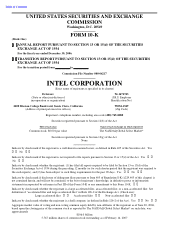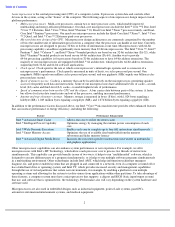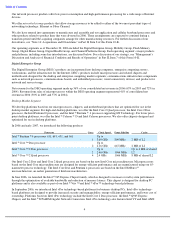Intel 2006 Annual Report Download - page 13
Download and view the complete annual report
Please find page 13 of the 2006 Intel annual report below. You can navigate through the pages in the report by either clicking on the pages listed below, or by using the keyword search tool below to find specific information within the annual report.
Table of Contents
NOR Flash Memory
We develop NOR flash memory products for cellular phones and embedded form factors. We offer a broad range of memory
densities, leading-edge packaging technology, and high-performance functionality. Intel StrataFlash wireless memory,
designed for mobile phones, allows two bits of data to be stored in each NOR memory cell for higher storage capacity and
lower cost. In addition to product offerings for cellular customers, we offer NOR flash memory products that meet the needs
of other market segments, such as the embedded market segment. The embedded market segment includes set-top boxes,
networking products, DVD players, DSL and cable modems, and other devices.
Intel StrataFlash wireless memory is available in the Intel
®
Stacked Chip Scale Package as well as in the Intel ultra-thin
stacked chip-scale packaging. Intel Strata Flash wireless memory allows up to five ultra-thin memory chips to be stacked in
one package, delivering greater memory capacity and lower power consumption in a smaller package. With heights as low as 1
millimeter, the package allows manufacturers to increase memory density and provide features such as camera capabilities,
games, and e-mail in relatively thin cell phones. Our higher density flash products generally incorporate stacked RAM
and/or NAND flash, which in some instances we purchase from third-party vendors.
In August 2006, we introduced NOR flash memory products designed for the emerging low-cost cell phone market segment.
These products feature cost-
efficient NOR flash memory in densities ranging from 32 megabits (Mb) to 256 Mb, with optional
RAM in a multi-chip package. They are configured to work with low-cost, single-
chip baseband and radio frequency solutions
from leading chipset suppliers.
In September 2006, we began shipping Intel
®
Serial Flash Memory (S33) products designed for the NOR embedded market
segment. These offerings include densities ranging from 16 Mb to 64 Mb. Intel Serial Flash Memory offers smaller packages
compared to traditional NOR flash memory.
In December 2006, we began shipping our first NOR flash memory products using our 65-nanometer process technology.
These products have 1-gigabit (Gb) densities and are designed for the high-end cell phone market segment.
NAND Flash Memory
We develop NAND flash memory products for use primarily in memory cards, digital audio players, and cellular phones. In
February 2006, we began shipping our first NAND flash memory products. These products are currently available in densities
of up to 4 Gb, and in stacked packaging, in densities of up to 16 Gb. Additionally, we offer multi-level cell NAND flash
memory products. Our NAND flash products are manufactured by IMFT using either 72- or 90-
nanometer process technology.
Digital Home Group
The Digital Home Group designs and delivers products and platforms for consumer products such as PCs, digital TVs, and
networked media devices that meet the demands of consumers through a variety of linked digital devices within the home for
the enjoyment of digital media and other content. In January 2006, we began offering Intel Viiv technology-based platforms
for use in the digital home. In addition, we offer products for demodulation and tuner applications as well as processors and
chipsets for embedded consumer electronics designs such as digital televisions, digital video recorders, and set-top boxes.
PCs based on Intel Viiv technology are designed to make it easier to download, manage, and share the growing amount of
digital programming available worldwide, and view that programming on a choice of TVs, PCs, or handheld products. Intel
Viiv technology-based systems are designed to provide easier connectivity and interoperability with consumer electronics
devices compared to traditional PCs. Platforms based on Intel Viiv technology include one of the following processors: Intel
Core 2 Duo, Intel Core 2 Extreme, Intel Core 2 Extreme quad-core, Intel Core Duo, Intel Pentium D, or Pentium
®
Processor
Extreme Edition; as well as a chipset; a network connectivity device; and enabling software—
all optimized to work together in
the digital home environment.
In July 2006, we introduced the first digital home processor based on the new Intel Core microarchitecture. The Intel Core 2
Extreme processor X6800 is designed for gaming PCs, runs at a speed of 2.93 GHz, supports a 1066-MHz bus, and includes
4 MB of shared L2 cache.
In November 2006, we introduced the Intel Core 2 Extreme quad-core processor QX6700, the first quad-core desktop
processor designed for gaming PCs. This processor runs at a speed of 2.66 GHz, supports a 1066-MHz bus, includes 8 MB of
shared L2 cache, and supports 64-bit extensions and Intel VT.
7
























